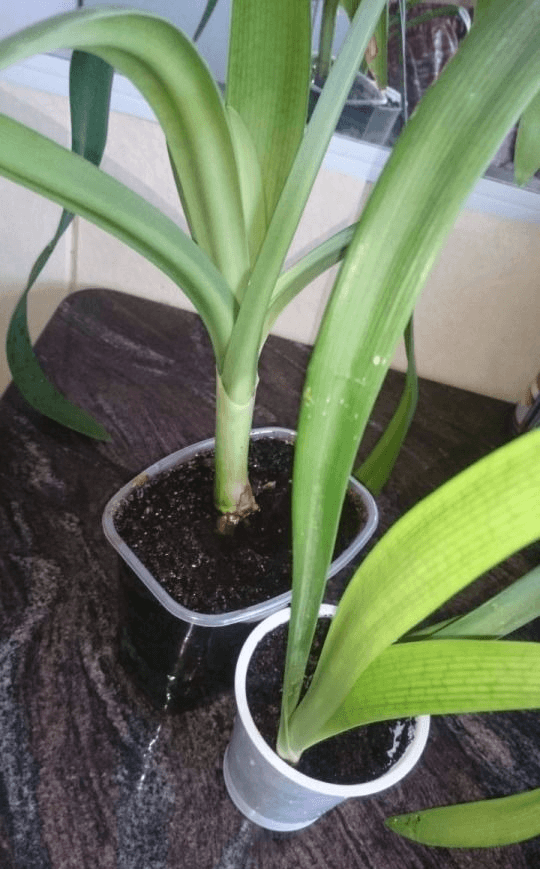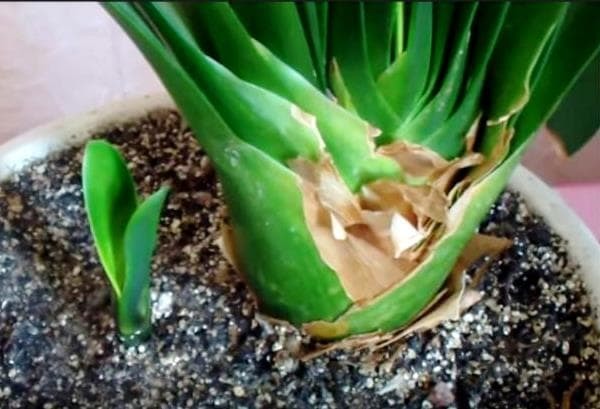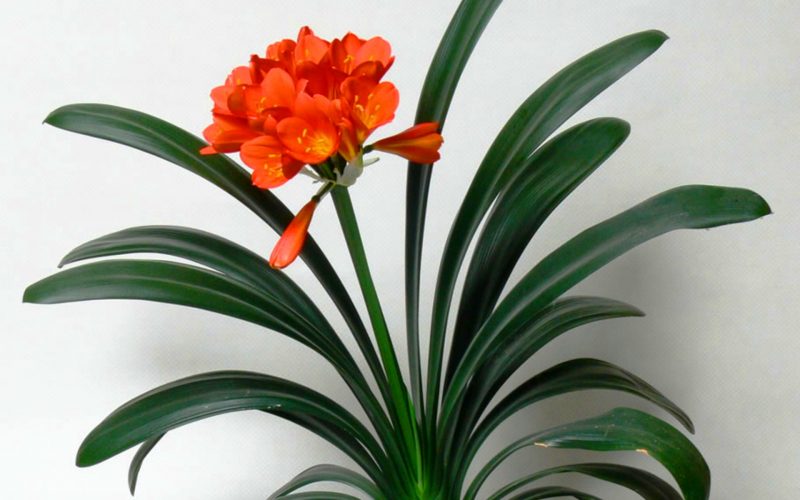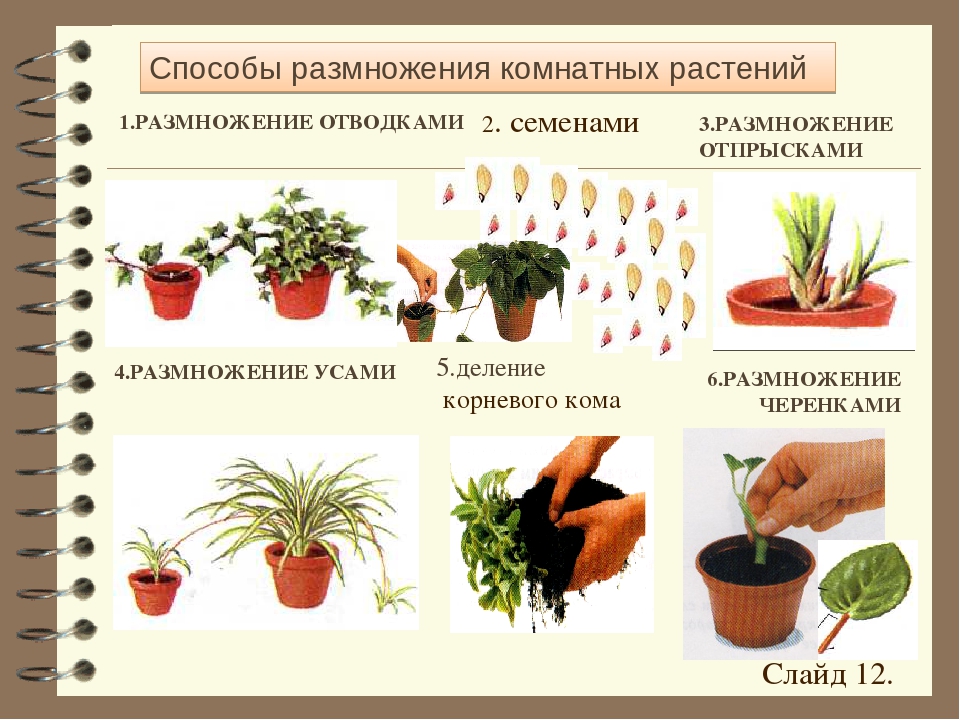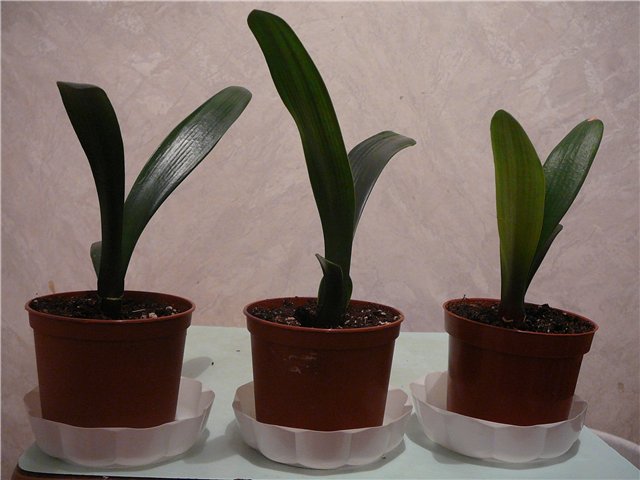Description of indoor plant Clivia
Clivia blooms every year if watered properly and not left in a warm room over the winter. She needs a lot of space, and in winter it is necessary to provide a dormant period in a cool room with very limited watering. Clivia does not like to be disturbed - they touch her once more and rearrange her from place to place. Clivia is a very long-lived plant; under appropriate conditions, it can live up to 40 years. Old plants growing in tubs are not transplanted, but only fertilized with fertilizers. The best specimens from old plants form up to 40-50 peduncles.
The leaves of the plant, the decorativeness of which can decorate your interior even without flowering, are collected in a root socket and are arranged in a kind of fan. Bright, cheerful orange clivia inflorescences, shaded by shiny dark green foliage, are extraordinarily beautiful. Clivia bloom during the winter. Currently, various varieties of clivia have been bred: from light ocher to dark red color of flowers with a whole range of warm orange and yellow tones.
Clivia is a genus of perennial evergreen herbaceous plants of the Amaryllidaceae family. Botanist John Lindley named the family in honor of the Duchess of Northumberland Charlotte Clive, the governess of the future Queen of Great Britain Victoria. The genus Clivia includes approximately five plant species of the amaryllis family.
Evergreen perennial herbaceous plants, stemless, multi-flowered. Vaginal leaves, tightly enclosing each other, forming a false stem, linear or xiphoid. Under the ground, clivia develops a rhizome, to which the thickened base of the leaves and the leaves themselves are attached. Clivia is, as it were, in the middle between bulbous and rhizome plants. The flowers are bell-shaped, red or orange, collected in an umbrella.
One of the most common - Clivia cinnabar (Clivia miniata - Latin miniatus - painted with cinnabar, covered with red paint from Latin minium - cinnabar or red lead) is a perennial herb of the Clivia genus of the Amaryllis family. In the greenhouse and indoor culture, it is used as a floral and deciduous ornamental pot plant. The homeland of the plant is South Africa.
In the literature, it is found under Russian names: orange clivia (dull red, red lead, red lead), or kaffir (Cape).
Reproduction methods
There is vegetative and seed propagation of clivia. Usually, the first method is used in room culture - reproduction with the help of lateral processes - children. This plant is rarely propagated by seeds.
Reproduction by children
Babies or side shoots are formed on the stem of the plant near its root. Usually, young clivia do not give children up to 5 years of age. Lateral processes can be seen only in sufficiently overgrown adult plants, which have already bloomed more than once.
Not all formed babies can be separated!
For successful rooting, it is necessary that the children have at least 4 leaves. Therefore, the newly grown little offspring should not be separated.
The shoots are removed from the mature plant during transplantation after flowering ends. They are cut from the stem with a sharp knife, and the cuts are rubbed with activated carbon.
The roots of the clivia break easily and then rot; the clivia should be separated very carefully and carefully!
After the children are separated, they are planted in small pots with a diameter of no more than 7 cm. Coarse washed wet sand serves as the substrate for rooting. The temperature is maintained in the range of 18-20 ° C. Water the shoots so that the sand remains slightly damp.Excess moisture leads to rotting of children.
Rooted children are transplanted into separate pots with soil, which includes leaf and turf soil, humus and sand in equal parts. They bloom already in the 2nd year of life.
Sowing seeds
Having clivias in bloom makes it very easy to get their seeds. But this is a long process. After pollination, the fruit sets and ripens for about 10 months. It is better to sow fresh seeds, it is not recommended to store them.
For sowing seeds, take a container with a soil mixture consisting of turf, peat and sand in a ratio of 2: 1: 2. Clivia seeds are laid out on the surface of the soil at a distance of 2 cm from each other and lightly sprinkled with earth from above. For seed germination, the temperature should be around 20 ° C and the soil should be kept moist with a water spray. After 1-1.5 months, the seeds germinate.
Until the appearance of the second leaf, young plants are kept in a container, and then transplanted into separate pots no more than 7 cm in diameter. The seedlings will grow in them for 1 year. During this year, 4-6 leaves are already formed on them.
In the second year, more spacious pots will be needed for clivia seedlings. Their diameter should be 9-10 cm. The soil for them should include turf, peat, humus and sand in equal parts. The transplant is carried out by the transshipment method. For the second year, seedlings grow 3 pairs of leaves.
In the third year, the seedlings are transplanted into pots with a diameter of 13 cm. In September, a dormant period is organized for them. At this time, they are not watered, and the temperature is reduced to 10-12 ° C. The rest lasts about 2 months. After that, when the temperature in the room rises to 20 ° C, some of the seedlings are already blooming. During the third year of life, they grow 2 pairs of leaves.
The fourth year of maintenance does not differ from the third, but the dormant period can last all winter until flower stalks appear on the plants. In the 4th year, the vast majority of seedlings bloom.
Types and varieties
The most popular is the orange clivia miniata or, as it is also called, cinnabar clivia. The height of the flower is 50-60 cm, the inflorescences are bright orange in color, often with a yellow center. This species has become the main one in the selection of new varieties and hybrid forms.
A well-known hybrid of this species, Clivia miniata var. citrina is distinguished by creamy yellow flowers, often with an orange tint at the base.

Clivia miniata var. citrina
Numerous varieties differ in the color of the inflorescences. Chubb's Peach - peach flowers, Chubb Peach Green Bird - white-lime, Cindy - pale pink, white-pink Cinderella, bright orange Clorine Meese, Clementine - lemon with light green and orange at the top of the petals, white clivia Aurea, variegata group and its striata cultivar with variegated leaves and many others.

Clivia nobilis from the Cape of Good Hope. In addition to flowering, it practically does not differ from cinnabar clivia. Its leaves are a little narrower, and the flowers in the form of unopened buds are drooping, crimson-red. There is also a rare pale yellow form of the species.
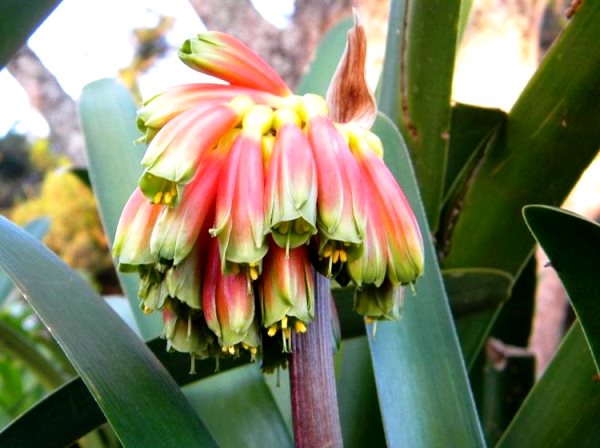
Most of the hybrids are created as a result of interspecific crosses, for example, Clivia cyrtanthiflora or the magnificent interspecific hybrids "Chanel", "Parfait" and many others.
Why clivia can get sick
The problems with growing clivia have two culprits: pests and improper care.
If the plant refuses to bloom, pay attention to lighting and temperature. Too little or too much light and temperatures above normal prevent the flower arrow from forming
Correct the situation and the plant will bloom.
Clivia leaves turn brown - the soil is waterlogged. Reduce watering.
White spots on the leaves appear after sunburn. Shade the place where the flower stands.
The plant has no children and leaves fade, provide it with the right feeding.
Pests
The main enemies of the clivia include the scale insect and mealybug. The scale is marked on the plant with brown spots.When attacked by a worm, the leaves bend and dry out. Wiping the leaves with soapy water and processing with actelik will help to cope with parasites.
If you want to get a plant with an orange-yellow mood and excellent decorative qualities, provide the clivia with optimal conditions, and a gorgeous bouquet will appear in your house in winter. For three weeks he will delight you with his beauty, causing surprise and delight among friends and acquaintances.
Reproduction
Several methods are used to breed clivia at home. Each grower chooses an option based on his experience and preferences.
Reproduction is carried out:
- Side shoots. Small shoots are used that are formed on the sides of the mother plant. They should have 3-4 leaves at the time of transplantation. They are moved into small pots 7-8 cm in diameter. The young shoots are not watered for the first 2 days. After that, they regularly, but not abundantly, moisten the soil.
- Seeds. The easiest way to get seed is from a gardening store. So it is more likely that they will ascend. If artificial pollination was carried out at home and the fruits are finally ripe, they collect the planting material on their own. Pre-soak it for a day in warm water. After that, the seeds are sown in a separate container, deepening them by no more than 1 cm. Cover with glass to create a greenhouse effect, periodically ventilate and moisten the soil. When the clivia has 1 strong leaf each, the seedlings dive into separate containers and provide the plant's standard care.
- By dividing the bush. It is advisable to use this method at the time of plant transplantation. The root system is divided into several parts, the cuts are treated with a root stimulator or sprinkled with crushed charcoal. After seating in separate containers, do not water for the first three days. It is worth remembering that the flowering of clivia propagated in this way will begin only after 2-3 years.

Flower varieties
At the moment, there are 23 varieties of this flower. The main types and their distinctive features:
- Clivia cinnabar (Clivia miniata). The bush has a rosette with long sharp leaves of a dark green color. On the leaves there are oblong stripes of white or yellow. The length of the foliage reaches 60 cm. The height of the bush varies between 45-50 cm. During flowering, inflorescences with funnel-shaped red buds are formed. Clivia Miniata is most often grown by flower growers;
- Lemon clivia (Clivia miniata Citrina). The bush bears great resemblance to the cinnabar variety. The main difference is the creamy yellow color of the leaves. The resulting berries also have a yellowish tint;
- Clivia the beautiful, or Nobilis (Clivia nobilis). It is a perennial stemless plant with leaves collected in a rosette that look like a sword. From bell-shaped flowers, umbellate or racemose inflorescences are formed, 14 pcs. The flowers are orange with a pinkish tint. The height of orange clivia can be 30-50 cm.
For your information! The genus of the flower was named by the English botanist D. Lindley, who described the plant, in honor of the Duchess Charlotte-Clivia.
Necessary conditions for growing
The main requirement for the breeder is to provide competent care in the winter. If you do not follow the rules of care, the clivia bulb will be depleted, and the peduncle will not be laid. At the beginning of the flowering phase, a gradual increase in temperature to room standards is allowed. The transition period between winter and spring should not be neglected.
Location and lighting
Summer for clivia will pass safely if the temperature of the plant is not lowered below 20 ° C and not raised above 25. In winter, cool is preferable. In November, it is recommended to place the clivia in a moderately lit room with a temperature of at least 14 ° C. The lighting is preferably bright and diffused, but prolonged contact with the sun's rays is unacceptable.
Air humidity
Clivia is insensitive to humidity. If the temperature and location parameters are correct, it is not necessary to monitor the air. Washing of leaves is allowed if dust has accumulated on them.
Soil and pot requirements
Soil for clivia should be prepared from sod-type soil in half with leaf. Thinning with sand is acceptable, but only coarse fraction. It is imperative to have a hole for draining excess water in the pot and a drainage layer. Store-bought primer will also work, but to use it, you should read the requirements indicated on the package. The choice of soil should be from those oriented to bulbous plants.

How to care for your clivia
Caring for clivia at home does not imply complex procedures, only watering on schedule and feeding. If the conditions for the existence of a flower during the dormant period (autumn-winter) are fully provided, then the grower has nothing to worry about.
To prevent the plant from wilting, wintering should take place in a cool microclimate. The coolness will allow the clivia to rest before it begins to form the peduncle. After rest, flowering follows (late winter-spring), during which it is necessary to gradually increase the temperature to 17-20 ° C. At the end of flowering, the plant is recommended to return to winter mode until late spring.
The summer season for clivia is better outdoors. In conditions of contact with the environment, the plant demonstrates the most intensive growth.
It is important to choose a shady place to install the pot, as direct contact with the sun's rays can burn the leaves. At the end of August, when the nights become noticeably colder, it is recommended to return the clivia to the house.
The need for watering
It is worth carefully monitoring the doses of moisture when watering. The plant is sensitive to excess water - rot and fungus will develop faster in clivia than in another similar flower.
Top dressing
Top dressing is appropriate only during periods of activity (late spring-summer), no more than once a month. Top dressing 2 times a month is permissible at the discretion of the breeder. Any organic fertilizers are suitable; when choosing a specific brand, it is recommended to consult a seller. Mineral nutrition is also acceptable, but in this case the breeder will have to prepare the solution on his own and monitor the proportion of the components. In addition, inorganic fertilizers can negatively affect flowering if you overdo it with dosages.
Pests and diseases
The main enemies of clivia are mealy bugs and scale insects. The first are small and white insects. They settle in the hole of the leaves. The second are black and brown formations. The dimensions of the scale are up to 1 cm in diameter.
In the fight against scale insects and worms, the Aktar remedy will help. To achieve the effect, you should not only douse the leaves with the agent, but also include it in watering until the result is noticeable. The substance does not threaten the plant, only harmful organisms.
Clivia is prone to fungal ailments, in particular root rot and bulbous decay. A sign of the development of a fungal disease - the leaves acquire an unpleasant brown tint and wither
It is important to recognize the fungus at an early stage and immediately begin to eliminate it, otherwise the plant cannot be saved. A breeder who recognizes the disease at an early stage should take out the flower of the pot and wash the roots with warm water, then treat them with Phytosporin.
Next, the affected areas are removed, and the resulting incisions are treated with activated carbon.
Description of the plant and types of indoor clivia
Clivias have long been considered obsolete and purely greenhouse plants, but today they are gaining popularity again in indoor culture. This is one of the most original plants among the beautifully flowering indoor plants and one of the brightest exotic plants.
Also known as the Kaffir lily, members of the Amaryllis clivia family are controversial.This plant is literally overgrown with myths. Even the belonging of clivia to rhizome perennials or bulbous plants is argued.
Clivias have a thickened, shortened rhizome that resembles a daylily and do not form bulbs. Specific clivias reach a height of 80 cm, modern varieties and hybrids are much more compact.
Arranged in two rows, belt-shaped or oar-shaped, rather long and wide leaves form false stems. Up to 60 cm long, clivia leaves are reminiscent of daylilies. But, thanks to the rich color and density, giving the leaves a slight arched bend, they win in comparison. Plants have a very effective glossy sheen.
Clivias can surprise many, but first of all - their longevity. Clivia can please 40 years or more under the right growing conditions!
Despite the classic flowering period from late February to May, clivia often blooms a little later, in March. On strong, powerful peduncles, umbrellas of inflorescences rise above the leaves. Young clivias produce one or more peduncles, but old overgrown plants, especially after the first decade, are able to please fifty peduncles per season.
Up to 60 large funnel-shaped flowers are collected in the umbellate inflorescences of the clivia. The graceful bells are very elegant. After flowering, large berry-like fruits are tied.
The yellow-orange hues of clivia flowers are reminiscent of summer fruits. Creamy, apricot, melon, pinkish peach, cinnabar pink clivias always look sunny and dazzlingly bright.
Clivias belong to the poisonous houseplants, which require protection of the skin from any contact with sap during work.
Types of indoor clivia
Clivia cinnabar, or clivia orange (Clivia miniata) - the most common and vibrant type of clivia. Belt-shaped leaves with a very dark shade of color are striking in their beauty. But this species is appreciated for flowering - massive yellow, orange or light red inflorescences of large flowers.
Clivia nobilis differs only in elongated tubular drooping flowers of predominantly pink color.
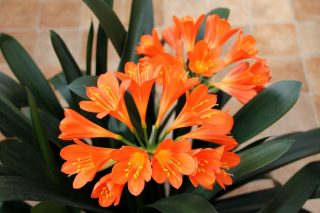 Clivia cinnabar, or Clivia orange (Clivia miniata). Nasr Habib Abdalla
Clivia cinnabar, or Clivia orange (Clivia miniata). Nasr Habib Abdalla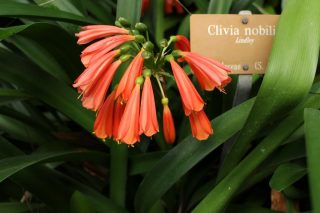 Clivia nobilis. Ghassen labidi
Clivia nobilis. Ghassen labidi
Caring for Clevia at home
Although many flower growers assure that Clivia does not need special care, nevertheless, in order for her to grow well, bloom profusely, and not be exposed to various diseases, she should be given attention
Soil mixture
The best option is a mixture consisting of turf and leafy soil, as well as sand (proportion 2: 2: 1). The bottom of the pot must be covered with a layer of pebbles or small bricks, which will serve as drainage.
Location, illumination
Clivia does not tolerate direct sunlight, so the plant pot must be placed on the east or west side of the room. It can also be placed on a northern windowsill, but in this case, Clivia will grow slowly, and you can not wait for flowering. In summer, the flower pot can be taken out into the garden by placing it in partial shade.
Temperature regime
Clivia is doing well at normal room temperature. During the growing season of the plant, the optimum air temperature should be approximately + 20-25 ° С, during dormancy - + 12-14 ° С. When a peduncle appears, it is recommended to transfer the plant to a room where the air temperature is + 18-20 ° C.
Watering Clivia
Watering should be moderate. Do not allow water to accumulate in the pan - this can lead to rotting of the root system. The clivias stop watering when they are dormant. When buds appear on the peduncle, watering is abundant. Water at room temperature is used.
Top dressing
Klivia should be fed during the period of active growth and during flowering. During the flowering period, fertilizers are applied twice a month. It is necessary to use fertilizers in which nitrogen is contained in a small amount.
Dormant period
In October or November, Clivia needs to provide a dormant period, which should last for 2-3 months. To do this, the plant is transferred to a cooler room (approximate air temperature + 10-12 ° C), stops watered.
Pests
Sometimes Clivia can be attacked by a scale insect or mealybug. You can get rid of them using folk methods, for example, wipe the plant with a sponge dipped in soapy water, or treat it with an insecticide solution.
Diseases and pests of clivia
The plant signals in different ways about the presence of problems that need to be dealt with. Below are the causes of diseases and methods of elimination:
- The lower leaves turn yellow, fall off, new ones appear - this is a common update.
-
All leaves turn yellow:
- little water (provide watering);
- a lot of moisture (allow the soil to dry, if the roots decay, dig out the flower, remove the affected roots, treat the sections with crushed activated carbon, transplant the plant into a new container and substrate);
- lack of nutrients (feed with fertilizers once every 2 weeks);
- depletion during the period of fruit formation and seed ripening (cut off fruits and peduncles when dry);
-
transplanting, changing the position of the pot, drafts.
- The tips of the leaves turn yellow - insufficient air humidity (spray and place the pot away from heating devices).
- The middle of the leaf plates dries up, brown spots with a white edging appear - sunburn (protect the plants from their aggressive effects, do not water in direct sunlight).
-
Clivia wilted.
- if the leaves are sluggish, there is a lack of moisture (urgently water the soil and spray the plant);
- if the leaves are elastic, the angle of incidence of sunlight has changed.
- Weak new growth, no flowers - hot (find a cooler corner).
- No increase is observed - it is cold (to provide heat).
-
Leaves rot - damage to the root system during transplantation (leave only healthy white roots, remove the rest, disinfect the sections and transplant the plant).
- The tips of the leaves turn brown, the base rots - excess moisture (you need to allow the soil to dry, control the recovery of the clivia and water less often, if decay, remove the affected parts and transplant into fresh soil).
- Rusty stripes along the entire length of the leaves are a fungal disease (should be treated with Oxychom or another fungicide according to the instructions).
Of the pests, clivia can be chosen by shield aphids and mealybugs:
- Red sticky patches and brown plaques on leaves and stems are signs of scale insects. First, you can try to eliminate the pest mechanically - wipe the plant with soapy water. Then - apply Actellik insectoacaricide.
- Mealybugs give out a white loose bloom on the plant. You can also find the pests themselves, white and oval. A small number of worms can be removed with a damp swab. Against a large colony, you need to use the same Actellik or other insecticides.
Growing and caring at home

In addition to unpretentiousness and beautiful flowering, clivia is also a long-lived flower. With proper care, it can delight more than one decade.
Location and lighting
This perennial prefers diffused bright light; direct sunlight should be avoided. It is better to place the flower on the western and eastern windowsill. The north side is not the best option for clivia. With a lack of light, it grows very slowly and may not bloom at all. When placing on the south side, care must be taken to darken the window. In the summer season, if possible, expose the plant to the street, balcony or terrace, remembering to protect it from the sun's rays. The main thing is not to move or transplant the flower during flowering and bud development, the plant will shed its foliage. If the perennial was rearranged for some reason, then place it on the same side as in the previous place.
Temperature regime
The optimum temperature for a flower during the period of active growth should be in the region of +20 - + 25 ° C. When the plant produces a peduncle, the temperature is lowered to + 18 ° C - + 20 ° C. The rest of the time, it is necessary to maintain a temperature of + 12 ° C- + 14 ° C to lay the kidneys for the next season. In adults, the dormant period is longer than in young specimens.
The soil
The soil is harvested from equal proportions of leaf and sod land, mixing in a small amount of sand, preferably coarse-grained. Ordinary bulb soil can also be used. In this case, it is better to mix it with forest or garden soil in a 1: 1 ratio. It is necessary to make holes in the container for planting and use the drainage of their expanded clay, pebbles or stones.
Watering and humidity
This flower does not have much moisture requirements. If the temperature regime is observed, then the plant does not need additional moisture. In hot, dry summer weather, you can spray the leaves in the mornings and evenings, or simply wipe them down with a damp cloth to remove dust. Moderate watering is recommended, since with an excess of moisture, the trunk and leaves turn brown, and the root system begins to rot. Watered with settled water after the topsoil dries. Excess water must be emptied from the pallet. The frequency of watering is increased after the plant has ejected the peduncle and until the flower is completely blooming. Reduce after watering. A perennial at rest, it is enough to water 1-2 times a month to preserve the foliage.
Fertilizer
Klivia is fertilized from March to August from the first year of life. At the same time, liquid organic and mineral fertilizers are used 2 times a month (2 g per 1 liter of water) alternately. During the rest period, fertilization is stopped.
Transfer

The plant really does not like to be disturbed. Therefore, it is necessary to transplant it as needed, when the roots are already very cramped in the pot. After flowering, adult specimens are transplanted from an old container into a new, larger one no more than 1 time in 2-3 years. Young - can be replanted annually, but without damaging the roots. If damaged, they should be sprinkled with activated carbon to avoid root rot. Plants that are more than 10 years old cannot be transplanted, they are recommended to replace the topsoil annually (about 5 cm). When transplanting, the container is chosen about 3-5 cm more than the previous one, the plant should be a little cramped. This increases the flowering period. Be sure to check the pot for drainage holes. What should be the quality of the soil was discussed above.
Reproduction
Reproduction of clivia occurs in two ways: seed and vegetative.
The first method is not widespread due to its inefficiency. To obtain seeds, it is necessary to cross-pollinate the flower. And only in case of successful pollination, a green ovary is formed. In the process of ripening, the berry becomes soft and takes on a reddish tint. Ripe seeds are planted in nutrient soil at a distance of 2 cm. The first shoots appear only after 6 months. They are transplanted into separate containers only after the leaves are released by the sprouts. Further, the transplant is carried out as needed and the growth of the plant. After 2 years, starting in autumn, the flower is left alone, since it will begin to bloom only from 3-4 years of age.

The vegetative method is the most favorable for this perennial. When the flower babies form 4-5 leaves, they are separated from the main plant. In this process, the main thing is not to damage the roots. If the flower is in the flowering period, it is forbidden to carry out the reproduction procedure. The sprouts are placed in pots of no more than 7 cm. The optimum temperature for rooting shoots is 16-18 ° C. Water in moderation, avoiding stagnation of water in the soil. Young plants begin to bloom only after 2-3 years.
Home care
Clivia home care does not require any special skills from the owner.
Top dressing
To look good, especially during flowering, clivias need regular feeding. They begin to be applied already in the first year of life, once every two weeks (organic and mineral fertilizers alternate).
An adult plant is fed only during the flowering period.
Important! Nitrogen postpones flowering, potassium, on the contrary, can make it bloom more abundantly
Location and lighting
It is better to place the pot with clivia on the east or west windows of the house and provide it with enough space. On the north side, the plant needs to be backlit; on the south windows, the clivia needs to be shaded a little.
Watering
Waterlogging of the soil has a detrimental effect on the plant. Therefore, it is watered only after the soil in the pot dries up; excess moisture from the pan is removed immediately. A constant excess of moisture can lead to root rot.
Note! For irrigation, use soft water without chlorine three to four degrees warmer than room temperature. Clivia does not need high humidity (40-50% is enough), but dust accumulated on the leaves negatively affects the flower
Clivia does not need high humidity (40-50% is enough), but dust accumulated on the leaves negatively affects the flower.
Dormant period
Clivia should bloom, then the peduncle is cut off and the plant is left alone for 80-90 days. During this period, feeding is stopped, watering is carried out once every 10-12 days, the air temperature is lowered and the intensity of illumination is reduced.
At the end of the "hibernation" period, the plant is returned to its usual place, giving it a warm shower before that, feed it and water it sufficiently.
Important! The rest period must be stopped in a timely manner, otherwise the peduncle will grow crooked and weakened











